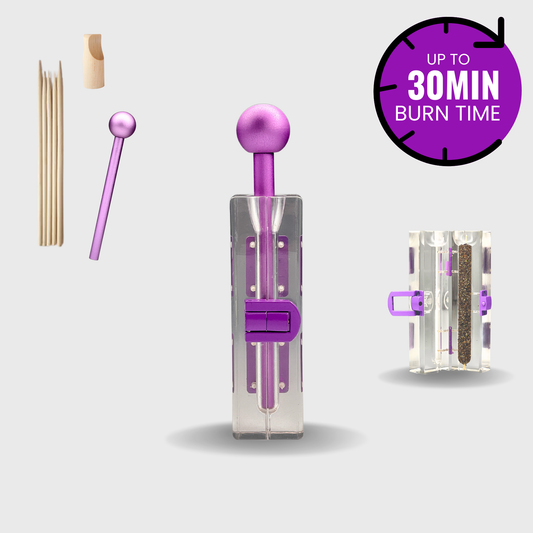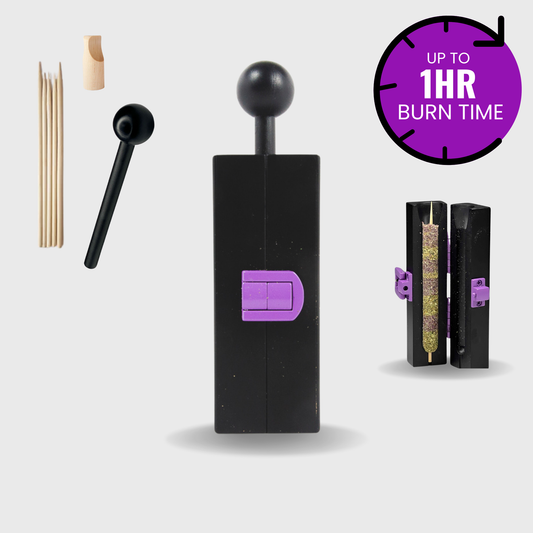⬇️ Prefer to listen instead? ⬇️
- 66% of marijuana consumers say inflation has led them to cut back on cannabis spending.
- Despite stable prices, cannabis businesses face up to 80% effective tax rates due to IRS Code 280E.
- Federal policy delays prevent the 280E tax burden from lifting even with possible rescheduling.
- Consumers are seeking budget-conscious alternatives like DIY methods and cost-saving tools.
- Cannagar molds help consumers maximize product efficiency and social smoking without overspending.
Inflation isn't just pressuring your grocery bill or housing costs—it’s reshaping how marijuana consumers approach their cannabis routines. Recent findings show a significant shift in cannabis spending behavior, driven by economic strain and compounded by outdated federal tax codes.
But with rising financial awareness, cannabis users are developing smarter habits. They are turning limitations into ways to be more efficient, creative, and sustainable with their cannabis.

The Numbers: Poll Data on Cannabis Spending Habits
As inflation tightens its grip across industries, cannabis is far from immune. A recent survey conducted between February 27 and March 2, 2024, revealed that a striking 66% of cannabis consumers are reducing their cannabis spending due to inflation. Surveying 518 marijuana consumers nationwide, the report paints a clear picture: even one of the most steadily growing industries is being affected by broader economic pressures.
This marks a sharp change in trajectory. Just a few months earlier, in November 2023, the same research organization reported that the majority of marijuana consumers expected to increase their cannabis spending by 2025. A different study in early 2024 suggested seven in ten users still anticipated either steady or rising cannabis spending in the near future.
Yet now, fewer are willing—or able—to follow through on those expectations. A key takeaway is that consumer intent doesn’t always align with real economic capability. Consumers may want to maintain or increase usage, but real-world inflation is forcing their hand.
Who Is (And Isn’t) Cutting Back?
Interestingly, roughly 34% of consumers say their cannabis budgets remain unaffected. These may be:
- Individuals with higher disposable incomes
- Medical users who consider cannabis essential rather than optional
- Long-time users with well-refined consumption strategies
- People living in states where cannabis is more affordable due to mature legal markets
Still, the two-thirds majority reflects growing economic insecurity, even within a culture known for resilience and adaptability.

Why Consumers Are Spending Less: Price Increases or Budget Shifts?
When looking at the reasons behind shrinking cannabis budgets, one thing becomes clear: it’s not just about the price of weed—it’s about the cost of living overall. In many legal markets, cannabis prices have actually remained relatively stable or even declined due to increased competition and product availability. However, broader inflation in rent, groceries, transportation, and health care is consuming larger portions of consumer budgets.
Essential vs. Non-Essential Spending
Faced with limited resources, many consumers are being forced to prioritize. And for all its benefits, cannabis often falls into the “non-essential” category for casual users. This leads to:
- Delayed or reduced dispensary visits
- Switching to lower-cost product forms
- Decreased impulse buying
Even those who view cannabis as part of their health and wellness are looking for ways to get the most out of their use, find good value, and plan how they use it.

The Policy Behind the Pain: How IRS Code 280E Drives Up Prices
Although inflation is taking a toll across the board, there's a unique factor keeping weed prices artificially high: the infamous IRS Code 280E. This federal tax statute stems from cannabis's classification as a Schedule I controlled substance, grouping it alongside heroin and LSD.
What Is IRS Code 280E?
IRS Section 280E was passed in the 1980s. It stops businesses that deal with Schedule I or II substances from writing off normal business costs. That means cannabis companies—even those operating legally within their states—can’t deduct costs like:
- Employee wages
- Marketing expenses
- Office rent
- Insurance or utilities
- Packaging and branding
This leads to really high tax rates—sometimes up to 70–80%. These excessive costs are passed through the supply chain directly to consumers.
The Ripple Effect on Cannabis Spending
With limited ability to reinvest in their business or offer competitive pricing, cannabis companies have little choice but to keep prices high. The consumer, already strapped for cash elsewhere, is left facing stubbornly high cannabis costs even in a maturing market.

Policy Progress Stalls: Hope Deferred for Cannabis Tax Relief
For a time, marijuana consumers and the cannabis industry alike pinned their hopes on federal rescheduling. The Biden administration has endorsed moving cannabis from Schedule I to Schedule III, a move that would eliminate many of 280E's restrictions. However, the process has hit roadblocks.
The Political Pushback
As policy stalls, some lawmakers are actively working to block progress. Also, GOP representatives have introduced a bill that would keep the 280E limits in place, even if cannabis is rescheduled.
This creates legal and financial limbo. Without a decision, cannabis businesses and their customers are stuck between old policy and today's needs. A market with rules can't do well, or even lower prices, without clear rules.

The Consumer Response: Adapting Behavior, Rethinking Rituals
In response to this combination of personal economic strain and inflated pricing, cannabis users are getting strategic.
How Inflation Is Changing Marijuana Consumption Habits
Budgeting cannabis use doesn’t have to mean giving it up entirely. Instead, consumers are taking a smarter approach. Today's trends show that many marijuana consumers are:
- Buying in bulk to get discounts for buying more
- Choosing flower over concentrates, edibles, or specialty products
- Buying less frequently, but more intentionally
- Sharing less in social settings
- Trying out ways to save money, like vaporizing or microdosing
This “less is more” mindset reflects a maturing market and a user base that's developing a more ritualized, intentional connection with cannabis.
Stretching Your Stash: Saving Without Sacrifice
One of the most effective responses to inflation is identifying ways to extend the life of your stash—without compromising the experience. More users are using tools and ways of doing things that help them be exact and efficient.
Rolling With Precision: The Role of Cannagar Molds
Among the best investments you can make as a budget-conscious smoker is a Cannagar mold. Unlike pre-rolls or small pipes, Cannagars offer:
- Dense, slow-burning rolls that last hours
- Even airflow that prevents runs and canoeing
- A smoother hit that delivers full flower flavor
- Significantly reduced waste per session
With Purple Rose Supply’s Cannagar mold kits, you don't have to be a rolling expert to build top-tier cannagars. These kits are accessible, reusable, and designed for everyday consumers who want more from less.
The Group Smoke Reimagined: Affordable & Social
Smoking with friends can quickly drain your stash—and budget. But the cannagar is built for longevity, making it good for group sessions that don't cost a lot.
Cannagars: The Social Smoker’s Secret Weapon
Instead of passing around multiple joints or reheating dab rigs, a single cannagar can serve several people over a long stretch of time. That makes it:
- Perfect for parties or social settings
- Comparable in cost to rolling multiple joints—but more efficient
- Looks good and gives a good experience, but without costing extra
- In short, you're getting more value per gram, both in experience and actual usage time.

The DIY Revolution: Getting Luxury Without Spending It
Dispensary pre-rolls offer convenience, but they often come with a hefty markup. For consumers trying to stretch their budget, rolling your own cannagar can give you high-quality results without the ongoing cost.
What You Need (and Don’t Need)
Thanks to Purple Rose Supply, all it takes is:
- Your own flower
- A Cannagar mold kit
- A bit of patience
No expensive third-party wraps or CO2 technology required. The results show it—a longer burn, a smoother smoke, and a good experience that fits your budget.
Long-Term Thinking: Smart Tools for Sustained Use
Inflation isn’t likely going anywhere fast. That means planning ahead and investing in tools that improve your ritual without costing too much is important.
Why Reusability Matters
One smart thing marijuana consumers can do is choose tools and accessories you can use again and again. A Cannagar mold pays for itself in a few uses by allowing you to roll premium sessions using your own flower, saving you from overpriced store-bought alternatives.
If you’re aiming for sustainability, affordability, and consistent quality, then smart tools are your best friend.
Crafting a Better Ritual: Inflation-Proof, Satisfaction-Approved
Being frugal with cannabis doesn’t mean being joyless. Instead, it helps people use cannabis carefully. Making a ritual that’s better, planned, and fits your budget can make your connection with cannabis stronger.
From solo sessions to social circles, stretching your stash can become part of the fun, not the fallback option.

A New Era: Redefining the Cannabis Consumer in 2024
Cannabis has long been a symbol of counter-culture adaptability. As marijuana consumers face increased costs, shrinking budgets, and unclear policy futures, they’re leaning into that legacy of resilience and innovation.
The cannabis consumer of today isn’t just a smoker—they're a strategist, product researcher, and efficient economist. With the right tools—like a Cannagar mold from Purple Rose Supply—you can keep the good parts of your cannabis ritual without hurting your money.
Ready to stretch your stash and make your sessions better? See all the Cannagar Molds at Purple Rose Supply. Take control of how you use cannabis—one smart session at a time.




